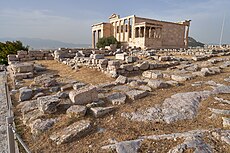Category:Pandroseion
ancient sanctuary in the Acropolis of Athens | |||||
| Upload media | |||||
| Instance of | |||||
|---|---|---|---|---|---|
| Dedicated to | |||||
| Culture | |||||
| Location |
| ||||
 | |||||
| |||||
The Pandroseion was founded in the area of the Acropolis where the oldest sacred spots of the Athenians were preserved, such as the signs of the contest between Athena and Poseidon for the patronage of the city; the sacred olive tree, which sprung when the goddess struck the rock with her spear, giving her the victory; the salty spring, which appeared when Poseidon struck his trident; and the tomb of king Kekrops, who was the judge or a witness of the contest of the two gods, according to the myth. The sacred olive tree of Athena was enclosed in the sanctuary of Pandrosos, while Kekrops' tomb was protected by a separate precinct wall at the southeast. The early Pandroseion, whose form is unknown, was destructed by the Persians in 480 B.C. Today, a few remains of the classical sanctuary are preserved at the west wall of the Erechtheion, as well as parts of the foundation of its north boundary. These remains indicate that it was an oper-air sanctuary of a trapezoidal plan with a stoa of the Ionic Order at the north side. The entrance of the sanctuary was a small propylon (gate) at the east end of the stoa. The altar of Herkeios Zeus, protector of the family, was located in the court under the sacred olive tree.
The Pandroseion underwent alterations when the Erechtheion was built attached to its east side (431-406 B.C. or 421-406 B.C.). Then, the entrance was through a small undecorated wall at the right of the elaborate at the north porch of the Erechtheion. At that time, the court of the sanctuary was paved and part of Cecrops' tomb was integrated under the porch of the Caryatids. The olive tree that exists in the sanctuary today was planted in the beginning of the 20th cent. in memory of Athena's sacred tree." (text : information board by the ruins).Media in category "Pandroseion"
The following 10 files are in this category, out of 10 total.
-
20140407 athenes90.JPG 3,872 × 2,592; 4.29 MB
-
Athen Pandroseion sacred-olive-tree 20230921 131241.jpg 2,240 × 3,526; 3.3 MB
-
Athens, Greece - panoramio (60).jpg 3,072 × 2,048; 879 KB
-
Pandroseion 1.jpg 6,000 × 4,000; 8.85 MB
-
Pandroseion.jpg 564 × 358; 26 KB
-
Plan of Pandroseion.png 1,350 × 786; 47 KB
-
Ruins of the Pandroseion on May 19, 2020.jpg 6,000 × 4,000; 28.88 MB
-
The Pandresion Sanctuary.jpg 1,690 × 2,254; 979 KB
-
View of the Erechtheion and the Pandrodeion on the Acropolis on April 28, 2021.jpg 6,000 × 4,000; 23.08 MB










